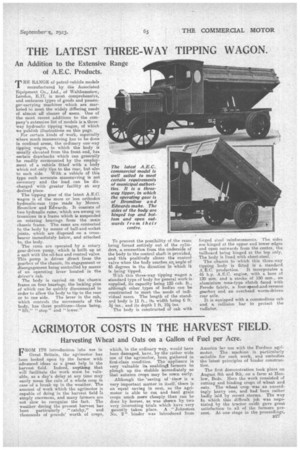AGRIMOTOR COSTS IN THE HARVEST FIELD.
Page 9

Page 10

If you've noticed an error in this article please click here to report it so we can fix it.
Harvesting Wheat and Oats on a Gallon of Fuel per Acre.
PROM ITS introduction into use in Great Britain, the agrimotor has been looked upon by the farmer with advanced ideas as a great help in the harvest field. Indeed, anytlang that will facilitate the work must be valuable, as a day's delay at any time may easily mean the ruin of a whole crop in case of a break up in the weather. The amount of work which the agrimotor is capable of doing in the harvest field is simply enormous, and many farmers are not slow to recognize the fait. The weather during the present harvest has been particularly " catchy," and thousands of pounds worth of crops, which, in the ordinary way, would have been damaged, have, by the rather wide use of the agrimotor, been gathered in first-class condition. The appliance is very valuable in errablingt farmers to plough up the stubble immediately so that autumn crops may be sown early.
Although: the.'saving of time is a very important matter in itself: there is an equal saving in cost., as the agrimotor is able to cut and haul grain 'crops much more cheaply than can be done by horses, as was shown by two very interesting trials which have very ascently taken place. A "Johnston No. 2' binder was introduced from America for use with the Fordson agrimotor. The machine is particularly suitable for such work, and embodies the latest principles of binder construction.
The first demonstration took place on August 8th and 9th, on a farm at Hen low, Beds. Here the work consisted of cutting and binding crops a wheat and oats. The wheat crop was an exceedingly heavy one, and had been rather badly laid by recent storms. The way In which this difficult job was negotiated by the tractor outfit gave great satisfaction to all of the farmers present. At .one stage in the proceedings, the rate at which the work was being accomplished was carefully noted. In 2 hours and 10 minutes a little less than 7 acres was cut, and, during this time, in spite of the difficulties already mentioned, the paraffin consumption worked out at approximately 1 gallon per acre. On the second day a fairly heavy crop of oats was handled. In this instance 7 acres were cut in 2i hours, whilst rather less than 1 gallon of paraffin per acre was used.
A further demonstration took place at Foxton, near Cambridge, where a field of "Red Standard" wheat, which promised to yield about 4 qrs. to the acre, was cut with a 7-ft. model of the "Johnston No. 2." binder, This job was also accomplished very satisfactorily, the rate of work and fuel consumption proving similar to those already quoted for the Henlow trial. At both of these demonstrations general satisfaction was expressed with the working of the floating elevator on the binder, which enables the machine to handle light or heavy crops equally efficiently. The "Johnston No. 2" possesses a good sturdy frame, but the makers claim that the fact that roller bearings have been introduced into the machine wherever possible reduces the draught to the point where it is as light as that of any binder on the market, and • that considerable economy is effected in the amount of twine used.




























